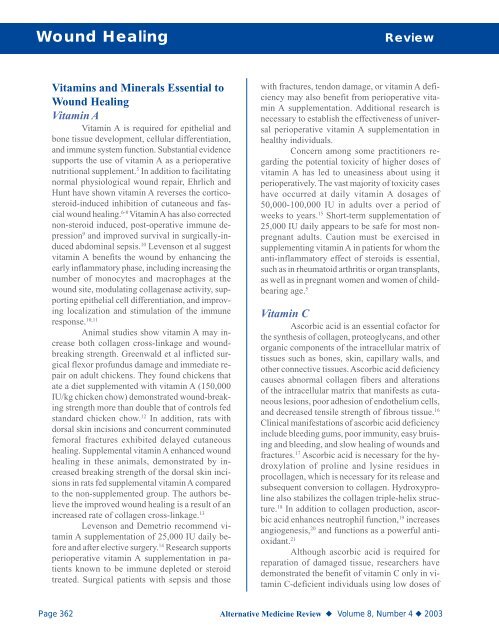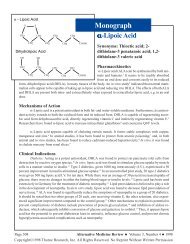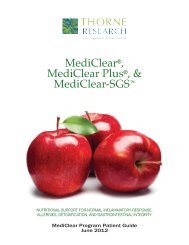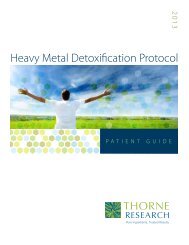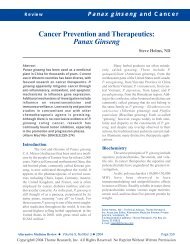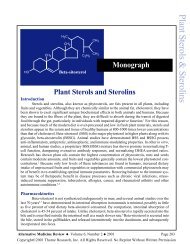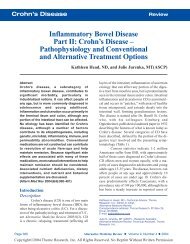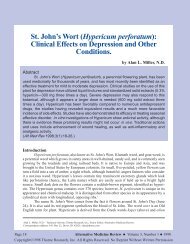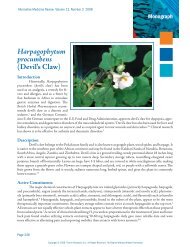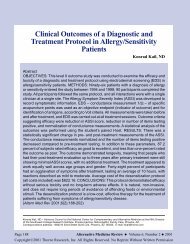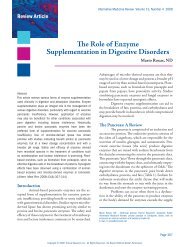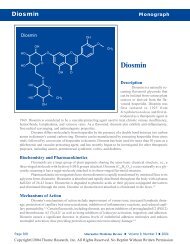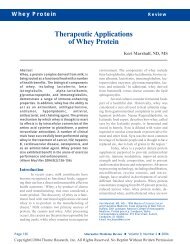Create successful ePaper yourself
Turn your PDF publications into a flip-book with our unique Google optimized e-Paper software.
<strong>Wound</strong> <strong>Healing</strong> Review<br />
Vitamins and Minerals Essential to<br />
<strong>Wound</strong> <strong>Healing</strong><br />
Vitamin A<br />
Vitamin A is required for epithelial and<br />
bone tissue development, cellular differentiation,<br />
and immune system function. Substantial evidence<br />
supports the use of vitamin A as a perioperative<br />
nutritional supplement. 5 In addition to facilitating<br />
normal physiological wound repair, Ehrlich and<br />
Hunt have shown vitamin A reverses the corticosteroid-induced<br />
inhibition of cutaneous and fascial<br />
wound healing. 6-8 Vitamin A has also corrected<br />
non-steroid induced, post-operative immune depression<br />
9 and improved survival in surgically-induced<br />
abdominal sepsis. 10 Levenson et al suggest<br />
vitamin A benefits the wound by enhancing the<br />
early inflammatory phase, including increasing the<br />
number of monocytes and macrophages at the<br />
wound site, modulating collagenase activity, supporting<br />
epithelial cell differentiation, and improving<br />
localization and stimulation of the immune<br />
response. 10,11<br />
Animal studies show vitamin A may increase<br />
both collagen cross-linkage and woundbreaking<br />
strength. Greenwald et al inflicted surgical<br />
flexor profundus damage and immediate repair<br />
on adult chickens. They found chickens that<br />
ate a diet supplemented with vitamin A (150,000<br />
IU/kg chicken chow) demonstrated wound-breaking<br />
strength more than double that of controls fed<br />
standard chicken chow. 12 In addition, rats with<br />
dorsal skin incisions and concurrent comminuted<br />
femoral fractures exhibited delayed cutaneous<br />
healing. Supplemental vitamin A enhanced wound<br />
healing in these animals, demonstrated by increased<br />
breaking strength of the dorsal skin incisions<br />
in rats fed supplemental vitamin A compared<br />
to the non-supplemented group. The authors believe<br />
the improved wound healing is a result of an<br />
increased rate of collagen cross-linkage. 13<br />
Levenson and Demetrio recommend vitamin<br />
A supplementation of 25,000 IU daily before<br />
and after elective surgery. 14 <strong>Research</strong> supports<br />
perioperative vitamin A supplementation in patients<br />
known to be immune depleted or steroid<br />
treated. Surgical patients with sepsis and those<br />
with fractures, tendon damage, or vitamin A deficiency<br />
may also benefit from perioperative vitamin<br />
A supplementation. Additional research is<br />
necessary to establish the effectiveness of universal<br />
perioperative vitamin A supplementation in<br />
healthy individuals.<br />
Concern among some practitioners regarding<br />
the potential toxicity of higher doses of<br />
vitamin A has led to uneasiness about using it<br />
perioperatively. The vast majority of toxicity cases<br />
have occurred at daily vitamin A dosages of<br />
50,000-100,000 IU in adults over a period of<br />
weeks to years. 15 Short-term supplementation of<br />
25,000 IU daily appears to be safe for most nonpregnant<br />
adults. Caution must be exercised in<br />
supplementing vitamin A in patients for whom the<br />
anti-inflammatory effect of steroids is essential,<br />
such as in rheumatoid arthritis or organ transplants,<br />
as well as in pregnant women and women of childbearing<br />
age. 5<br />
Vitamin C<br />
Ascorbic acid is an essential cofactor for<br />
the synthesis of collagen, proteoglycans, and other<br />
organic components of the intracellular matrix of<br />
tissues such as bones, skin, capillary walls, and<br />
other connective tissues. Ascorbic acid deficiency<br />
causes abnormal collagen fibers and alterations<br />
of the intracellular matrix that manifests as cutaneous<br />
lesions, poor adhesion of endothelium cells,<br />
and decreased tensile strength of fibrous tissue. 16<br />
Clinical manifestations of ascorbic acid deficiency<br />
include bleeding gums, poor immunity, easy bruising<br />
and bleeding, and slow healing of wounds and<br />
fractures. 17 Ascorbic acid is necessary for the hydroxylation<br />
of proline and lysine residues in<br />
procollagen, which is necessary for its release and<br />
subsequent conversion to collagen. Hydroxyproline<br />
also stabilizes the collagen triple-helix structure.<br />
18 In addition to collagen production, ascorbic<br />
acid enhances neutrophil function, 19 increases<br />
angiogenesis, 20 and functions as a powerful antioxidant.<br />
21<br />
Although ascorbic acid is required for<br />
reparation of damaged tissue, researchers have<br />
demonstrated the benefit of vitamin C only in vitamin<br />
C-deficient individuals using low doses of<br />
Page 362 Alternative Medicine Review ◆ Volume 8, Number 4 ◆ 2003


